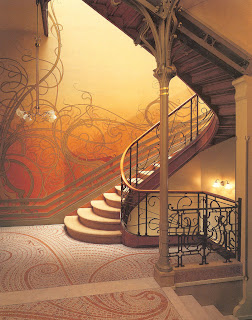The Bauhaus school was created when Walter Gropius was appointed head of two art schools in Weimar and united them in one. He coined the term Bauhaus as an inversion of 'Hausbau' - house construction. Gropius wanted to create a new unity of crafts, art and technology at a school with an international and interdisciplinary orientation. Its goal was the building as a Gesamtkunstwerk (total work of art). Through the innovative methods of an integrated way of teaching art, the idea was to equally prepare young artists in theory and practice for the new task.
 Teaching at the school concentrated on functional craftsmanship and students were encouraged to design with mass-produced goods in mind. Studies at the Bauhaus began with the obligatory preliminary course, which conveyed methods for working with artistic material using a new pedagogical and sometimes experimental approach. This was followed by training in the workshops that largely eliminated the separation between work and theory. The goal of the education was to apply what had been learned in the theory of building.
Teaching at the school concentrated on functional craftsmanship and students were encouraged to design with mass-produced goods in mind. Studies at the Bauhaus began with the obligatory preliminary course, which conveyed methods for working with artistic material using a new pedagogical and sometimes experimental approach. This was followed by training in the workshops that largely eliminated the separation between work and theory. The goal of the education was to apply what had been learned in the theory of building.The heart of the education was apprenticeship in the workshops, which offered a broad spectrum ranging from the processing of glass to the use of wood, ceramics and metal to stagecraft, typography, photography and advertising. The workshops were initially headed by the dual team of a craftsman as the work master and an artist as the master of form in order to guide art and technology into a new unity. The goal of the workshop activities was to apply the theory of building.
The small, international school – which very quickly made a name for itself – had an active political and cultural life that integrated all of the arts. Modern lifestyles were tested, women were allowed to study outside of the women’s classes and a libertarian approach prevailed. The parties, which were celebrated on the birthday of Walter Gropius and other occasions, were also legendary. Enormously controversial and unpopular with right wingers in Weimar, the school moved in 1925 to Dessau.
The Bauhaus moved again to Berlin in 1932 and was closed by the Nazis in 1933. The school had some illustrious names among it's teachers, including Paul Klee, Lyonel Feininger, Wassily Kandinsky, Laszlo Moholy-Nagy and Marcel Breuer. Its influence in design of architecture, furniture, typography and weaving has lasted to this day - the look of the modern environment is almost unthinkable without it. Like no other institution in Germany, the Bauhaus represents the modern age in the 20th century.
 Interview with Wilfred Franks (one of the few surviving students from the Bauhaus, dated 1999)
Interview with Wilfred Franks (one of the few surviving students from the Bauhaus, dated 1999) The Bauhaus Dessau Foundation Today
http://www.bauhaus-dessau.de/index.php?en
A comprehensive assembled collection represents the variety of assignments given to students at the Bauhaus in Weimar (1919-1925), Dessau (1925-1932), and Berlin (1932-1933)
http://library.getty.edu/cgi-bin/Pwebrecon.cgi?BBID=76390



